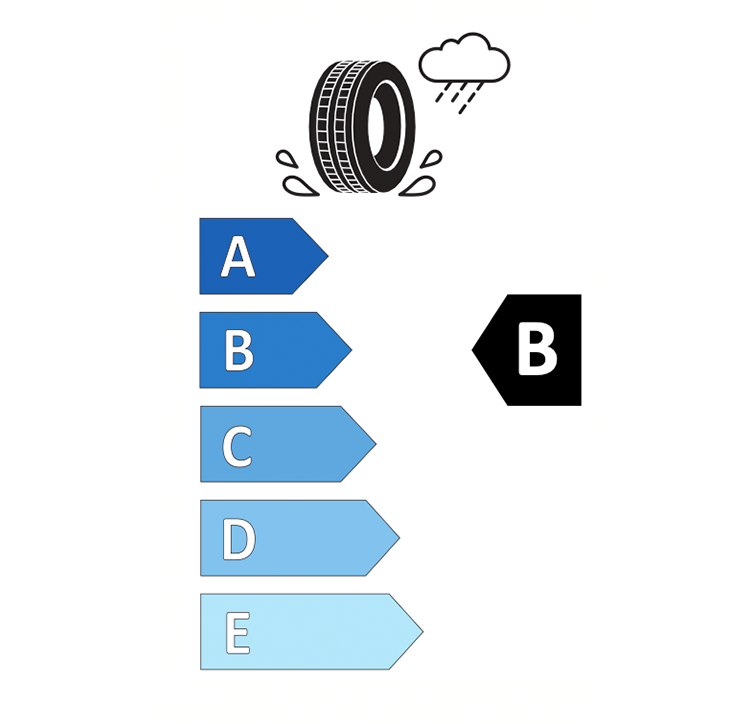EU labelling explained
EU implemented in 2012 tire labelling requirements regarding the display of information on the fuel efficiency, wet grip, and external rolling noise of tires. (Regulation (EC) 1222/2009 with amendments (EC) 228/2011 and (EC) 1235/2011). Its aim was to increase the safety, the environmental and economic efficiency of road transport in Europe. The labelling will allow end-users to make more informed choices when purchasing tires. This labelling regulation was in operation for 8 years.
To further enhance the tires safety and environmental information to the public, the regulation (EC) 1222/2009 was replaced with an upgraded regulation (EU) 2020/740. This regulation started to apply 1 May 2021
The main upgrades can be summarized:
• The label layout will follow EU standard ECO labelling schemes
• Public access to Label and Product Information Sheet via a QR code added to label
• Reorganisation of label classes.
• Only classes A-E will become available
• Introduction of Snow grip symbol on label (3PMSF)
• Label will be added to Truck tires (was not required before)

The new labelling scheme covers passenger car, light truck, bus and truck tires. For further details on the new EU tire labelling regulation please visit the official EU Commission website.
All tires that are now placed on EU market, will have to be registered in the EU Ecodesign/labelling portal (EPREL). Beside access to the digital label itself, a product information sheet can be accessed.
The public have now also access, via this EU portal, to information about all tires placed on EU market. A public database has been made available to search for any product registered there.
We at Giti welcome this upgraded labelling system, we are convinced it will guide our customers towards using safer, quieter, and more fuel-efficient tires. Our Research and Development Team have taken great care in designing tires that meet the highest safety and environmental standards and we are confident it will satisfy our customers.
What does the label inform about?

The tire label informs details of the manufacturer, internal product code, tire size description and tire class.
For Truck tires it grades 4 Performance criteria:
• Fuel efficiency
• Wet Grip
• Exterior noise from contact to the road surface
• Snow grip
For Fuel Efficiency and Wet Grip, the performance is expressed in 5 classes ranging from A (the most efficient) to E (the least efficient). For noise, the measured value is present on the label together with the letters A, B, C (A is lowest noise rating and C is the highest noise rating).
Fuel efficiency

Fuel consumption is influenced by tire deformation when rotating, resulting in energy losses in the form of heat. This is called the rolling resistance of the tire. The higher the deformation, the higher the tire rolling resistance and consequently more fuel is required to move the vehicle forward. In other words, lower rolling resistance means lower fuel consumption and therefore lower vehicle emissions, including CO2. The label displays different grades in “rolling resistance” where A is the most “fuel efficient” and E the least efficient in class.
The black arrow next to the grading indicates the performance level of the product.
Customers should be made aware that the actual fuel savings and road safety depend heavily on the behaviour of drivers, in particular the following: eco-driving can significantly reduce fuel consumption; the tire pressure needs to be correct and regularly checked for optimum fuel and wet grip efficiency and safety
Wet grip

The most important role of a tire is to provide safety - in all weather conditions.
Wet traction or grip is one of the most important performance characteristics of any tire.
There is typically a performance trade-off when combining noise, fuel efficiency and safety performances like wet grip.
The labelling will allow customers to prioritise for themselves their preferred performances.
The label will display a range of 5 grades where tires with an “A” provide the highest levels of wet grip and “E” the lowest.
Note: You should always respect the recommended stopping distances and keep safe distances when driving.
Exterior noise

Exterior tire noise levels are split into 3 categories and measured in decibel (dB) in comparison with the EU Regulative noise levels (ECE117).
A = 3dB less than the current EU limit value for this product
B = Compliant with the current EU limit value for this product.
C = Non-compliant with the current EU limit value for this product.
An increase of just a few decibels represents a big difference in noise levels. In fact, a difference of 3dB doubles the amount of external noise from the tire.
Snow grip

When the label has the 3PMSF symbol, it guarantees real winter performance by being specifically designed for snow use and the tire has passed a regulated objective test set out in ECE117, indicating it has a certain level of better snow traction than a so called SRTT tire. (Standard Reference Test Tire)

